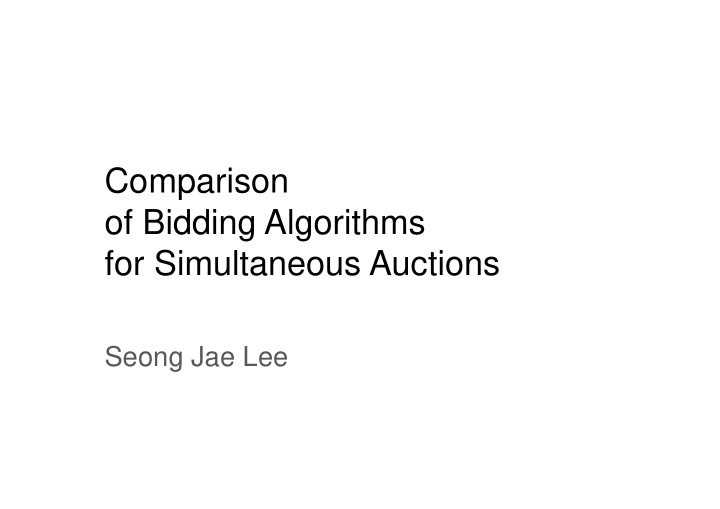



Comparison p of Bidding Algorithms f for Simultaneous Auctions Si lt A ti Seong Jae Lee g
Introduction Bidding Problem Bidding Problem • Simultaneous Auctions • Substitutable & Complementary Goods Substitutable & Complementary Goods
Introduction Bidding Problem: Goal Bidding Problem: Goal • The goal of bidding problem is to find a set of bids B that maximizes: – s : clearing price. g p – p(s) : probability that the clearing price is s . – v(s B) : value when the clearing price is s and – v(s,B) : value when the clearing price is s , and bid is B .
Introduction Trading Agent Competition Trading Agent Competition
Algorithms Algorithms Algorithms • Sample Average Approximation • Marginal Value Bidding Name Performance Algorithm 2000 1 st , 2003 1 st ATTac01 , Marginal Value g Walverine 2004 2 nd , 2005 3 rd , 2006 2 nd Marginal Value 2000 2 nd 2002 final RoxyBot RoxyBot 2000 2 , 2002 final Marginal Value Marginal Value 2005 final, 2006 1 st RoxyBot SAA
Algorithms Review: the Goal Review: the Goal • The goal of bidding problem is to find a set of bids B that maximizes: t fi d t f bid B th t i i – s : clearing prices. l i i – p(s) : probability that the clearing price is s . – v(s,B) : value when the clearing price is s , and bid is B .
Algorithms Sample Average Approximation Sample Average Approximation • SAA algorithm samples S scenarios from clearing price distribution model. l i i di t ib ti d l • Find a set of bids B that maximizes: – S : a set of sampled clearing prices.
Algorithms Sample Average Approximation Sample Average Approximation • There are infinitely many solutions! – e.g. S =1, s =100, g , , if B > s, v (s, B )=1000- s, else v(s,B) = 0 . – B can be any number between 100 and 1000 B can be any number between 100 and 1000. • SAA Bottom: maximize • SAA Top: maximize • SAA Top: maximize
Algorithms Sample Average Approximation Sample Average Approximation • Defect – The highest bid SAA Bottom considers submitting may be below clearing price. – SAA Top may pay more than the highest price it expects. p SAA Bottom SAA Top
Algorithms Marginal Value based Algorithms Marginal Value based Algorithms • Marginal Value of a good: the additional value derived from owning the good l d i d f i th d relative to the set of goods you can buy. • Characterization Theorem [Greenwald] • Characterization Theorem [Greenwald] – MV(g) > s if g is in all optimal sets. – MV(g) = s if g is in some optimal sets. – MV(g) < s if g is not in any optimal sets. MV(g) s if g is not in any optimal sets.
Algorithms Marginal Value based Algorithms Marginal Value based Algorithms • Use MV based algorithms which performed well in the TAC: hi h f d ll i th TAC – TMU/TMU*: RoxyBot 2000 – BE/BE* : RoxyBot 2002 – AMU/SMU : ATTAC AMU/SMU : ATTAC
Experiments Experiments Experiments • Decision-Theoretic Setting – Prediction = Clearing Price (normal dist.) – Prediction ~ Clearing Price (normal dist.) • Game Theoretic Setting • Game-Theoretic Setting – Prediction ~ Clearing Price (CE price)
Experiments 1 Decision Theoretic (perfect) 1. Decision-Theoretic (perfect)
Experiments 1 Decision Theoretic (perfect) 1. Decision-Theoretic (perfect) • SAAs are more t l tolerant to variance t t i • SAAT ~ SAAB at a high variance at a high variance Variance
Experiments 2 Decision Theoretic (noise) 2. Decision-Theoretic (noise) Over- Under- Over- Under- prediction prediction prediction prediction Low Variance High Variance
Experiments 3 Game Theoretic (CE prices) 3. Game-Theoretic (CE prices) ? ?
Experiments 3 Game Theoretic (CE prices) 3. Game-Theoretic (CE prices) • Competitive Equilibrium [Wellman ’04] • P n+1 = P n + MAX(0, α P n (demand - supply)) supply price quantity
Experiments 3 Game Theoretic (CE prices) 3. Game-Theoretic (CE prices) Cdf of Prediction Cdf of Clearing Prices Prices
Experiments 3 Game Theoretic (CE prices) 3. Game-Theoretic (CE prices)
Experiments 3 Game Theoretic (CE prices) 3. Game-Theoretic (CE prices) Cdf Cdf of f Prediction C f Cdf of f Clearing Prices High Variance Low Variance
Experiments 3 Game Theoretic (CE prices) 3. Game-Theoretic (CE prices) L Low Variance V i Hi h V High Variance i
Conclusion Conclusion • Sample Average Approximation – Optimal for decision-theoretic setting, with infinite number of scenarios. – More tolerant to variance. – More tolerant to noise. More tolerant to noise. • SAA Top is tolerant to noise in general. • SAA Bottom is tolerant to noise in high variance SAA Bottom is tolerant to noise in high variance. – Showed a better performance even in a game-theoretic setting even in a game-theoretic setting.
Questions? Questions? Questions? Questions?
Acknowledgements Acknowledgements • Andries van Dam • Amy Greenwald • Victor Naroditskiy Victor Naroditskiy • Meinolf Sellmann
Recommend
More recommend